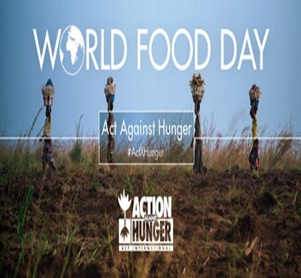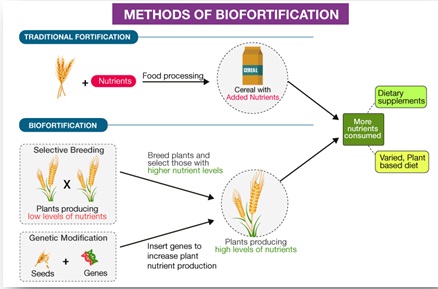
Context: Celebration of World Food Day on 16th October.
 Background: This year's World Food Day is dedicated to highlight food and agriculture as a significant part of COVID-19 response system. To mark the special day in India, Prime Minister has launched a commemorative coin and dedicated 17 bio-fortified varieties of eight crops to the nation to celebrate the establishment of the Food and Agriculture Organisation (FAO) 75 years ago, in 1945.
Background: This year's World Food Day is dedicated to highlight food and agriculture as a significant part of COVID-19 response system. To mark the special day in India, Prime Minister has launched a commemorative coin and dedicated 17 bio-fortified varieties of eight crops to the nation to celebrate the establishment of the Food and Agriculture Organisation (FAO) 75 years ago, in 1945.
History of World Food Day
It all started in the year 1979, when the United Nation's Food and Agriculture Organisation (FAO) marked October 16 of every year as World Food Day. This year’s World Food Day marks the 75th anniversary of FAO. If food historians are to be believed, initially, the day was celebrated to commemorate the establishment of FAO, but with change in time it turned into a global event, creating awareness about food shortage and reviving food systems across the globe.
|
Food and Agriculture Organization The FAO is a specialized agency of the United Nations that leads international efforts to defeat hunger. It was established in 1945, the Food and Agriculture Organisation (FAO) has its headquarters in Rome, Italy. Its goal is to achieve food security for all and make sure that people have regular access to enough high- Every year, FAO publishes a number of major 'State of the World' reports related to food, agriculture, forestry, fisheries and natural resources.
|
Theme
World Food Day is a channelized way that celebrates awareness about food shortage and reviving food systems across the globe. It is celebrated around a theme and keeping the pandemic in view, this year the theme is - "Grow, nourish, sustain. Together. Our actions are our future".
Significance of WFD
The day revolves around many programmes and activities that are related to food security and good nutrition for all. The key agenda of the day is to focus on food and nutrition of poor and underprivileged strata of the society around the world. World Food Day calls for global harmony to help all populations to recover from the crisis, and to boost the food systems for a better tomorrow. And this change will require improved social protection schemes and new opportunities planned and channelized through digitalization and e-commerce in the most sustainable way. FAO urges to celebrate this auspious day and applauds the people who produce, plant, harvest, fish or transport our food and thank the #FoodHeroes in every way possible.
Hunger and Nutrition
Almost 2 billion women and children in low and middle-income countries (LMICs) are at risk for vitamin A, iron, and zinc deficiencies, leading to more sickness, increased number of deaths and lower cognitive ability, all combining to reduce economic growth significantly.
The highest numbers of women and children suffering from this “hidden hunger” live in South Asia, especially India.
Causes of Hunger and Nutrition Deficiency
The primary underlying cause for mineral and vitamin deficiency is low-quality diet. The poor desire, but cannot afford to purchase sufficient quantities of vegetables, fruits, pulses, and animal products, which, gram for gram, contain relatively high amounts of bio-available minerals and vitamins, but whose prices have been rising much faster than staples like wheat, rice and corn over the past several decades.
Hence poor people satisfy their hunger by consuming large amounts of food staples, which only changes at higher levels of incomes.
Strategies to Address the Problem
To address the problem of low intake of minerals and vitamins through agriculture there are two broad strategies.
The first is to improve the densities of minerals and vitamins in the high amounts of food staples that the poor already consume. The second is to increase their consumption of nutritious non-staple foods. The second broad strategy fundamentally depends on raising incomes and lowering the real prices of non-staple foods.
Food staples are not dense on minerals and vitamins, but they do provide a broad range of essential minerals and vitamins a base which needs to be strengthened by non-staple foods. The absolute intake of minerals and vitamins from food staples is the result of multiplying quantities consumed with the density.
The sub-strategy of focusing on food staples, is to increase densities of nutritious components and decrease the densities of undesirable compounds. This can be performed by “bio-fortification.”
Bio-fortification is the process by which the nutritional quality of food crops is improved through agronomic practices, conventional plant breeding, or modern biotechnology.
Bio-fortification differs from conventional fortification in that biofortification aims to increase nutrient levels in crops during plant growth rather than through manual means during processing of the crops. Biofortification may therefore present a way to reach populations where supplementation and conventional fortification activities may be difficult to implement.
Examples of Bio-fortification
Conclusion
From that standpoint, Prime Minister’s endorsement of eight bio-fortified crops is commendable. The credit for this also goes to the Indian Agricultural Research Institute (IARI) and many agri-scientists of India, such as MS Swaminathan, for their long-term vision and perseverance to develop these bio-fortified crops.
These bio-fortified staples need to be closely linked to India’s food-based welfare programmes including the public distribution system (PDS) the mid-day meal and anganwadis and should become an integral part of the National Nutrition Mission (POSHAN Abhiyan). This would also help fight the adverse impact of Covid-19 on the nutrition of the country’s vulnerable population.
Agricultural policymakers typically focus on increasing productivity and farmers’ incomes. But investing in improved nutrition through agriculture has extremely high economic payoffs. The government should work for drawing attention to bio-fortified basic staples and linking it to public food programmes.
Connecting the Article
Question for Prelims : Consider the following statements
1. Food and Agriculture Organization is a specialized agency of UN.
2. Rural Development Report published by Food and Agriculture Organization.
Which of the statements given above is/are correct?
(a) 1 only
(b) 2 only
(c) Both 1 and 2
(d) Neither 1 nor 2
Answer (a)
Question for Mains : What is Bio-fortification ? How can it address the problem of nutrition deficiency ? Give examples

Our support team will be happy to assist you!
